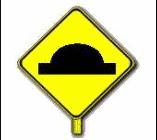
Explanation:
Driving too rapidly over a bump can cause your suspension to fail. This could cause your automobile to skid or, at the very least, weaken its grip. You should take it easy.
Explanation:
A bus station's general information sign.
Explanation:
A traffic controller will direct traffic ahead of you.
Explanation:
Airport general information sign.
Explanation:
Deer are about to cross. Be cautious and prepared to stop as you move slowly. In this region, deer have been known to cross the road.
Explanation:
At the beginning of a single road or street that ends in a dead end or cul-de-sac, the DEAD END (W14-1) sign may be used. When the W14-1 sign is used, it must be placed as close to the entry point as is reasonably reasonable or far enough in advance to allow the road user to turn around if necessary at the closest intersecting street in order to avoid the dead end or no outlet condition.
Explanation:
It's possible that road workers are working on the road, and you'll be told to slow down or stop.
Explanation:
Road users may be warned about workers on or near the route by a Workers (W21-1a) symbol sign.
Explanation:
A designated children's playground that is close to the road may be announced in advance using the playground (W15-1) sign. The playground sign might have a border and legend in black, with a fluorescent yellow or green background. Children are nearby, so slow down and pay attention.
Explanation:
A sign providing general information for a library.
Explanation:
Used to indicate a one-way street, expressway ramp, or the wrong direction or side of a divided highway. Drive around this sign; you are travelling in the wrong direction.
Explanation:
Traffic is allowed to pass on either side of an island, obstruction, or gore in the roadway, according to the Double Arrow (W12-1) sign, which can be used to warn other road users. This sign allows for the rejoining or reversal of traffic.
Explanation:
A pedestrian crossing is located ahead.
Explanation:
Black numbers on a white shield with a black background and no border make up U.S. Route signage. All U.S. routes as well as intersectional highways with route sign assemblies must use this sign.
Explanation:
This sign indicates that the intersection's give way regulations apply.
Explanation:
Traffic is only allowed to move in the direction indicated by the arrow.
Explanation:
Up ahead, a pedestrian crossing. Be prepared to pause and move slowly.
Explanation:
You're now traveling on a split road, which will soon merge with another road carrying traffic in the opposite direction to create two-way traffic.
Explanation:
Depending on the signage, you may need to give way at the intersection.
Explanation:
This sign indicates that traffic is flowing in both directions.